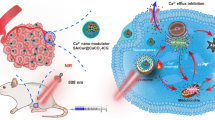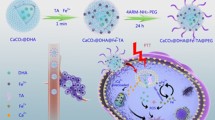Abstract
Abnormal metabolism has become a potential target for highly malignant and invasive triple-negative breast cancer (TNBC) due to its relatively low response to traditional therapeutics. The existing metabolic interventions demonstrated unsatisfactory therapeutic outcomes and potential systemic toxicity, resulting from the metabolic instability and limited targeting ability of inhibitors as well as complex tumor microenvironment. To address these limitations, here we developed a robust pyroelectric BaTiO3@Au core—shell nanostructure (BTO@Au) to selectively and persistently block energy generation of tumor cells. Stimulated by near-infrared (NIR) laser, the Au shell could generate heat to activate the BaTiO3 core to produce reactive oxygen species (ROS) regardless of the constrained microenvironment, thus prominently inhibits mitochondrial oxidative phosphorylation (OXPHOS) and reduces ATP production to induce TNBC cell apoptosis. The therapeutic effects have been well demonstrated in vitro and in vivo, paving a new way for the development of metabolic interventions.

Similar content being viewed by others
References
Bianchini, G.; Balko, J. M.; Mayer, I. A.; Sanders, M. E.; Gianni, L. Triple-negative breast cancer: Challenges and opportunities of a heterogeneous disease. Nat. Rev. Clin. Oncol. 2016, 13, 674–690.
Foulkes, W. D.; Smith, I. E.; Reis-Filho, J. S. Triple-negative breast cancer. N. Engl. J. Med. 2010, 363, 1938–1948.
Wu, Q.; Li, B.; Li, Z. Y.; Li, J. J.; Sun, S.; Sun, S. R. Cancer-associated adipocytes: Key players in breast cancer progression. J. Hematol. Oncol. 2019, 12, 95.
Rybinska, I.; Agresti, R.; Trapani, A.; Tagliabue, E.; Triulzi, T. Adipocytes in breast cancer, the thick and the thin. Cells 2020, 9, 560.
Bandini, E.; Rossi, T.; Gallerani, G.; Fabbri, F. Adipocytes and microRNAs crosstalk: A key tile in the mosaic of breast cancer microenvironment. Cancers (Basel) 2019, 11, 1451.
Kothari, C.; Diorio, C.; Durocher, F. The importance of breast adipose tissue in breast cancer. Int. J. Mol. Sci. 2020, 21, 5760.
Park, J. H.; Vithayathil, S.; Kumar, S.; Sung, P. L.; Dobrolecki, L. E.; Putluri, V.; Bhat, V. B.; Bhowmik, S. K.; Gupta, V.; Arora, K. et al. Fatty acid oxidation-driven Src links mitochondrial energy reprogramming and oncogenic properties in triple-negative breast cancer. Cell Rep. 2016, 14, 2154–2165.
Van Weverwijk, A.; Koundouros, N.; Iravani, M.; Ashenden, M.; Gao, Q.; Poulogiannis, G.; Jungwirth, U.; Isacke, C. M. Metabolic adaptability in metastatic breast cancer by AKR1B10-dependent balancing of glycolysis and fatty acid oxidation. Nat. Commun. 2019, 10, 2698.
Ariaans, G.; Jalving, M.; De Vries, E. G. E.; De Jong, S. Anti-tumor effects of everolimus and metformin are complementary and glucose-dependent in breast cancer cells. BMC Cancer 2017, 17, 232.
Molina, J. R.; Sun, Y. T.; Protopopova, M.; Gera, S.; Bandi, M.; Bristow, C.; McAfoos, T.; Morlacchi, P.; Ackroyd, J.; Agip, A. N. A. et al. An inhibitor of oxidative phosphorylation exploits cancer vulnerability. Nat. Med. 2018, 24, 1036–1046.
Ashton, T. M.; McKenna, W. G.; Kunz-Schughart, L. A.; Higgins, G. S. Oxidative phosphorylation as an emerging target in cancer therapy. Clin. Cancer Res. 2018, 24, 2482–2490.
Xu, Y. Y.; Guo, Y. D.; Chen, L.; Ni, D. L.; Hu, P.; Shi, J. L. Tumor chemical suffocation therapy by dual respiratory inhibitions. Chem. Sci. 2021, 12, 7763–7769.
Benjamin, D.; Colombi, M.; Hindupur, S. K.; Betz, C.; Lane, H. A.; El-Shemerly, M. Y. M.; Lu, M.; Quagliata, L.; Terracciano, L.; Moes, S. et al. Syrosingopine sensitizes cancer cells to killing by metformin. Sci. Adv. 2016, 2, 1601756.
Klosowski, E. M.; De Souza, B. T. L.; Mito, M. S.; Constantin, R. P.; Mantovanelli, G. C.; Mewes, J. M.; Bizerra, P. F. V.; Menezes, P. V. M. D. C.; Gilglioni, E. H.; Utsunomiya, K. S. et al. The photodynamic and direct actions of methylene blue on mitochondrial energy metabolism: A balance of the useful and harmful effects of this photosensitizer. Free Radical Biol. Med. 2020, 153, 34–53.
Lv, W.; Zhang, Z.; Zhang, K. Y.; Yang, H. R.; Liu, S. J.; Xu, A. Q.; Guo, S.; Zhao, Q.; Huang, W. A mitochondria-targeted photosensitizer showing improved photodynamic therapy effects under Hypoxia. Angew. Chem., Int. Ed. 2016, 55, 9947–9951.
Huang, H. Y.; Yu, B. L.; Zhang, P. Y.; Huang, J. J.; Chen, Y.; Gasser, G.; Ji, L. N.; Chao, H. Highly charged ruthenium(II) polypyridyl complexes as lysosome-localized photosensitizers for two-photon photodynamic therapy. Angew. Chem., Int. Ed. 2015, 54, 14049–14052.
Tang, Z. M.; Zhao, P. R.; Ni, D. L.; Liu, Y. Y.; Zhang, M.; Wang, H.; Zhang, H.; Gao, H. B.; Yao, Z. W.; Bu, W. B. Pyroelectric nanoplatform for NIR-II-triggered photothermal therapy with simultaneous pyroelectric dynamic therapy. Mater. Horiz. 2018, 5, 946–952.
Fang, R. H.; Kroll, A. V.; Zhang, L. F. Nanoparticle-based manipulation of antigen-presenting cells for cancer immunotherapy. Small 2015, 11, 5483–5496.
Zhang, D.; Wu, H. T.; Bowen, C. R.; Yang, Y. Recent advances in pyroelectric materials and applications. Small 2021, 17, 2103960.
Liow, C. H.; Lu, X.; Zeng, K. Y.; Li, S. Z.; Ho, G. W. Optically governed dynamic surface charge redistribution of hybrid plasmo-pyroelectric nanosystems. Small 2019, 15, 1903042.
Benke, A.; Mehner, E.; Rosenkranz, M.; Dmitrieva, E.; Leisegang, T.; Stöcker, H.; Pompe, W.; Meyer, D. C. Pyroelectrically driven ·OH generation by barium titanate and palladium nanoparticles. J. Phys. Chem. C 2015, 119, 18278–18286.
Chang, Y.; Cheng, Y.; Zheng, R. X.; Wu, X. Q.; Song, P. P.; Wang, Y. J.; Yan, J.; Zhang, H. Y. Plasmon-pyroelectric nanostructures used to produce a temperature-mediated reactive oxygen species for hypoxic tumor therapy. Nano Today 2021, 38, 101110.
Hao, F.; Nehl, C. L.; Hafner, J. H.; Nordlander, P. Plasmon resonances of a gold nanostar. Nano Lett. 2007, 7, 729–732.
Huang, X. H.; El-Sayed, I. H.; Qian, W.; El-Sayed, M. A. Cancer cell imaging and photothermal therapy in the near-infrared region by using gold nanorods. J. Am. Chem. Soc. 2006, 128, 2115–2120.
Skrabalak, S. E.; Chen, J. Y.; Au, L.; Lu, X. M.; Li, X. D.; Xia, Y. N. Gold nanocages for biomedical applications. Adv. Mater. 2007, 19, 3177–3184.
Čulić-Viskota, J.; Dempsey, W. P.; Fraser, S. E.; Pantazis, P. Surface functionalization of barium titanate SHG nanoprobes for in vivo imaging in zebrafish. Nat. Protoc. 2012, 7, 1618–1633.
Brinson, B. E.; Lassiter, J. B.; Levin, C. S.; Bardhan, R.; Mirin, N.; Halas, N. J. Nanoshells made easy: Improving Au layer growth on nanoparticle surfaces. Langmuir 2008, 24, 14166–14171.
Ok, K. M.; Chi, E. O.; Halasyamani, P. S. Bulk characterization methods for non-centrosymmetric materials: Second-harmonic generation, piezoelectricity, pyroelectricity, and ferroelectricity. Chem. Soc. Rev. 2006, 35, 710–717.
Haertling, G. H. Ferroelectric ceramics: History and technology. J. Am. Ceram. Soc. 1999, 82, 797–818.
Roper, D. K.; Ahn, W.; Hoepfner, M. Microscale heat transfer transduced by surface plasmon resonant gold nanoparticles. J. Phys. Chem. C 2007, 111, 3636–3641.
Richter, K.; Haslbeck, M.; Buchner, J. The heat shock response: Life on the verge of death. Mol. Cell 2010, 40, 253–266.
Nel, A.; Xia, T.; Mädler, L.; Li, N. Toxic potential of materials at the nanolevel. Science 2006, 311, 622–627.
Feng, Y. L.; Wang, G. R.; Chang, Y.; Cheng, Y.; Sun, B. B.; Wang, L. M.; Chen, C. Y.; Zhang, H. Y. Electron compensation effect suppressed silver Ion release and contributed safety of Au@Ag core—shell nanoparticles. Nano Lett. 2019, 19, 4478–4489.
Acknowledgements
This work was supported by the National Natural Science Foundation of China (Nos. 22007063 and 82002063), Shanxi Medical Key Science and Technology Project Plan of China (No. 2020XM01), the National University of Singapore Start-up Grant (No. NUHSRO/2020/133/Startup/08), NUS School of Medicine Nanomedicine Translational Research Program (No. NUHSRO/2021/034/TRP/09/Nanomedicine), the Science Research Start-up Fund for Doctor of Shanxi Province (No. XD1809 and XD2011), the Scientific and Technological Innovation Programs of Higher Education Institutions in Shanxi (No. 2019L0414), and Shanxi Province Science Foundation for Youths (No. 201901D211316). The authors would like to thank Chengdu Lilai Biotechnology Co., Ltd. for the cellular TEM measurement.
Author information
Authors and Affiliations
Corresponding authors
Electronic Supplementary Material
12274_2022_4927_MOESM1_ESM.pdf
BaTiO3@Au nanoheterostructure suppresses triple-negative breast cancer by persistently disrupting mitochondrial energy metabolism
Rights and permissions
About this article
Cite this article
Feng, Y., Wang, J., Ning, X. et al. BaTiO3@Au nanoheterostructure suppresses triple-negative breast cancer by persistently disrupting mitochondrial energy metabolism. Nano Res. 16, 2775–2785 (2023). https://doi.org/10.1007/s12274-022-4927-9
Received:
Revised:
Accepted:
Published:
Issue Date:
DOI: https://doi.org/10.1007/s12274-022-4927-9




